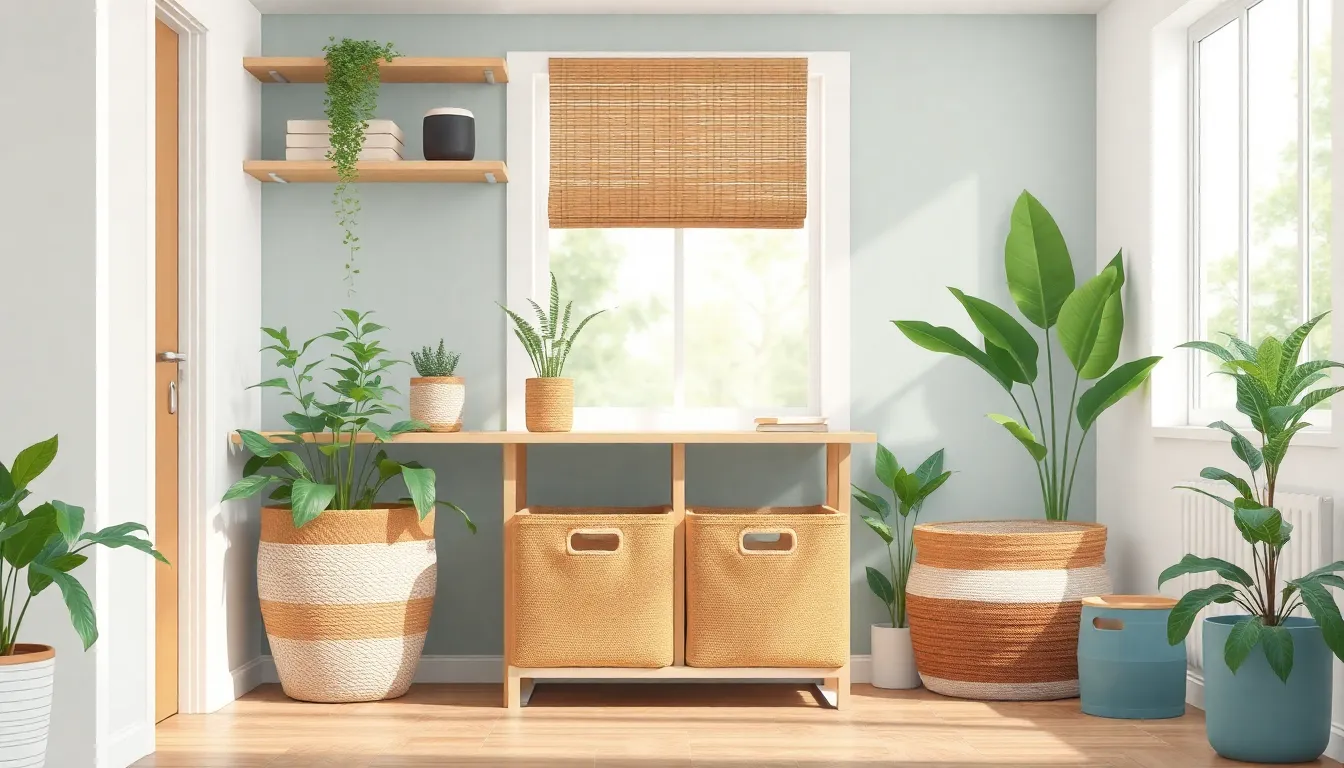In a world drowning in clutter, sustainable storage offers a lifeline that’s both eco-friendly and practical. Imagine transforming your chaotic spaces into organized oases while saving the planet—sounds like a win-win, right? With the right approach, decluttering doesn’t have to feel like a punishment; it can be a delightful adventure in creativity and responsibility.
Table of Contents
ToggleOverview of Sustainable Storage
Sustainable storage focuses on eco-friendly solutions to manage and organize belongings. This approach prioritizes minimizing waste and reducing environmental impact. Various strategies contribute to sustainable storage, such as using recycled materials for storage bins and choosing biodegradable options over plastic.
Eco-conscious consumers often gravitate towards products made from sustainable sources that last longer. Reusable containers exemplify one effective way to mitigate single-use plastic waste. Thrift stores and second-hand shops provide additional avenues for sourcing storage items, emphasizing reusing over buying new.
Locating furniture crafted from reclaimed wood or upcycled materials also supports sustainable practices. These options reduce the carbon footprint associated with manufacturing new goods. Additionally, modular storage systems allow for versatile space use, adapting to individuals’ needs while conserving resources.
Organizing techniques play a significant role in sustainable storage. Vertical space utilization, for instance, enhances efficiency without requiring excessive materials. Digital decluttering practices, like using cloud storage for documents, reduce physical storage needs and limit paper waste.
By integrating these sustainable storage methods, individuals can create harmonious spaces that reflect their commitment to environmental stewardship. Adopting these practices supports not only personal organization but also broader ecological objectives. The cumulative effect of these small changes contributes significantly to a greener planet.
Benefits of Sustainable Storage

Sustainable storage offers both environmental benefits and economic advantages, making it a practical choice for individuals looking to declutter responsibly.
Environmental Impact
Sustainable storage solutions actively reduce waste by using recycled and biodegradable materials. Utilizing storage bins crafted from recycled plastics minimizes new resource consumption, which decreases landfill contributions. Choosing thrifted items promotes reuse, thus lowering the demand for new products. Furniture made from reclaimed wood cuts down on carbon emissions linked to manufacturing. Additionally, digital decluttering through cloud storage eliminates paper usage, promoting a more sustainable lifestyle. Adopting these practices elevates environmental awareness while creating inviting, organized spaces.
Economic Advantages
Opting for sustainable storage leads to significant cost savings. Purchasing secondhand items from thrift stores often provides quality options at lower prices compared to new products. Investing in reusable storage solutions prevents repetitive purchases of disposable items, resulting in long-term savings. Many sustainable options, such as DIY projects using reclaimed materials, incur minimal costs. Furthermore, reducing clutter through these methods increases usable space, potentially enhancing property value. Aligning storage choices with sustainability not only benefits the planet but also supports financial well-being.
Types of Sustainable Storage Solutions
Sustainable storage solutions encompass various innovative methods focusing on eco-friendliness and efficiency. Below are key types of these solutions.
Renewable Energy Storage
Renewable energy storage systems capture energy from renewable sources, such as solar panels and wind turbines. These systems store excess energy for later use, providing a reliable power source during peak demand. Batteries made from lithium or other sustainable materials often power these solutions. Integrating renewable energy storage reduces dependence on fossil fuels and lowers greenhouse gas emissions, promoting energy independence. Options like community energy storage offer further benefits by sharing resources within neighborhoods, enhancing sustainability.
Eco-Friendly Material Storage
Eco-friendly material storage focuses on using sustainable resources for organizational needs. Recycled plastics, biodegradable materials, and sustainable wood comprise some of the primary materials used for storage solutions. Choosing storage bins made from these materials prevents plastic pollution and conserves natural resources. Additionally, using secondhand furniture and upcycled items helps minimize waste while promoting creative storage solutions. Individuals can explore thrift stores and online marketplaces for affordable options that align with sustainable practices. Overall, eco-friendly material storage contributes to a reduction in environmental impact while supporting a circular economy.
Implementation Strategies
Implementing sustainable storage involves strategic choices and mindful practices. This section outlines how to select appropriate storage solutions while embracing eco-friendly habits.
Choosing the Right Storage Solution
Selecting a sustainable storage solution requires evaluation of materials and sourcing. Recycled and biodegradable materials rank first due to their minimal environmental impact. Opt for storage bins made from reclaimed or recycled plastics and choose biodegradable options over traditional plastic. Thrift stores provide excellent sources for secondhand items, promoting reuse and reducing demand for new production. Whenever possible, consider furniture crafted from sustainable wood or upcycled materials. These choices support a circular economy and lower carbon footprints associated with manufacturing.
Best Practices for Sustainable Storage
Adopting best practices enhances the effectiveness of sustainable storage. Prioritize vertical space utilization to maximize organization and minimize ground clutter. Digital decluttering through cloud storage reduces reliance on physical storage and drastically cuts paper waste. Regularly reassess belongings to help identify unnecessary items for donation or reuse. Encourage the incorporation of eco-friendly practices into daily routines, such as using reusable containers instead of disposable ones. Connect with local initiatives that promote sustainable living, reinforcing community efforts towards environmentally conscious habits. These practices not only create efficient spaces but also contribute to broader sustainability goals.
Future Trends in Sustainable Storage
Rapid advancements in sustainable storage reflect a growing commitment to eco-friendly practices. Innovative designs utilize materials such as recycled plastics and reclaimed wood. Organizations increasingly prioritize renewable energy options in storage systems, enhancing efficiency while reducing reliance on fossil fuels.
Digital solutions continue to gain traction, with cloud storage minimizing physical storage needs. Utilizing apps to track and organize belongings promotes a streamlined approach to decluttering. Green packaging practices within the shipping industry further reduce waste associated with product delivery.
Emerging technologies enable energy storage systems to harness renewable sources like solar power. Innovations in biodegradable materials expand the range of sustainable options available for storage solutions. Additionally, trends show more individuals turning to thrift stores for secondhand items, reinforcing the circular economy’s importance.
Educational initiatives raise awareness about sustainable storage benefits, encouraging community participation. Partnerships between businesses and local organizations foster collaborative efforts aimed at promoting eco-friendly practices. Customized solutions based on individual needs emerge as a theme, catering to diverse storage requirements while keeping sustainability at the forefront.
Future trends in sustainable storage emphasize seamless integration of technology and eco-friendly practices. As consumer demand shifts toward responsible products, manufacturers are adapting their offerings to align with these values. Continuous improvement in sustainable storage options will create opportunities for individuals and organizations committed to a greener planet.
Sustainable storage is more than a trend; it’s a vital step toward a more organized and eco-conscious lifestyle. By embracing eco-friendly materials and innovative organizing techniques, individuals can transform their spaces while supporting the planet.
The shift towards sustainable storage practices not only minimizes waste but also fosters economic benefits through cost-effective solutions. As awareness grows and technology advances, the integration of sustainability in storage will become increasingly seamless.
Adopting these practices contributes to personal well-being and promotes a collective effort toward a greener future. By making conscious choices today, everyone can play a part in creating harmonious environments that reflect a commitment to sustainability.




